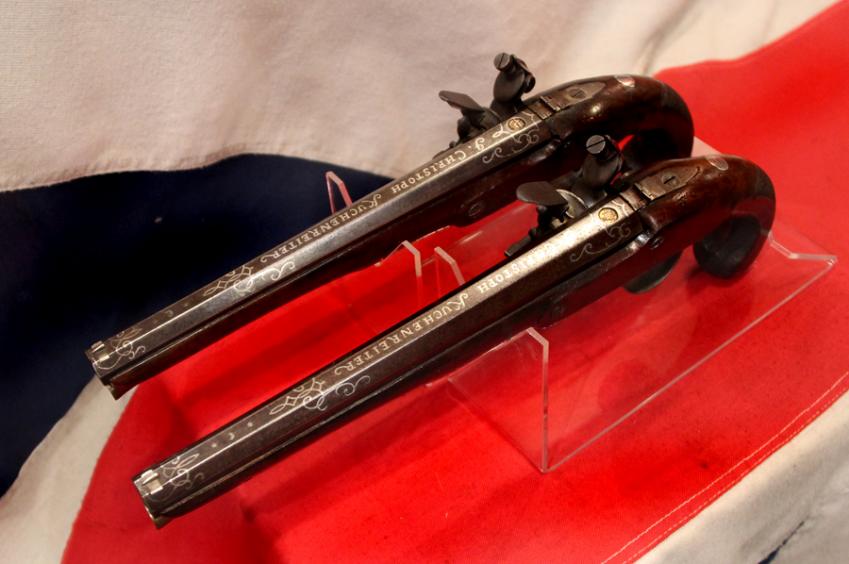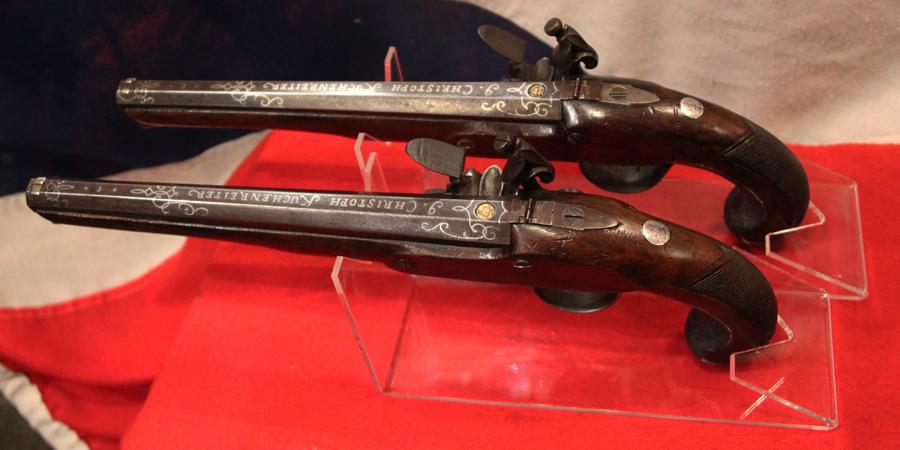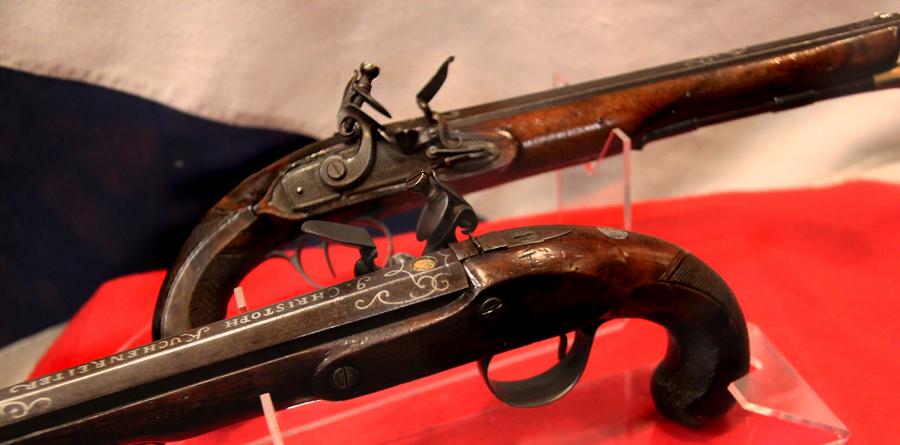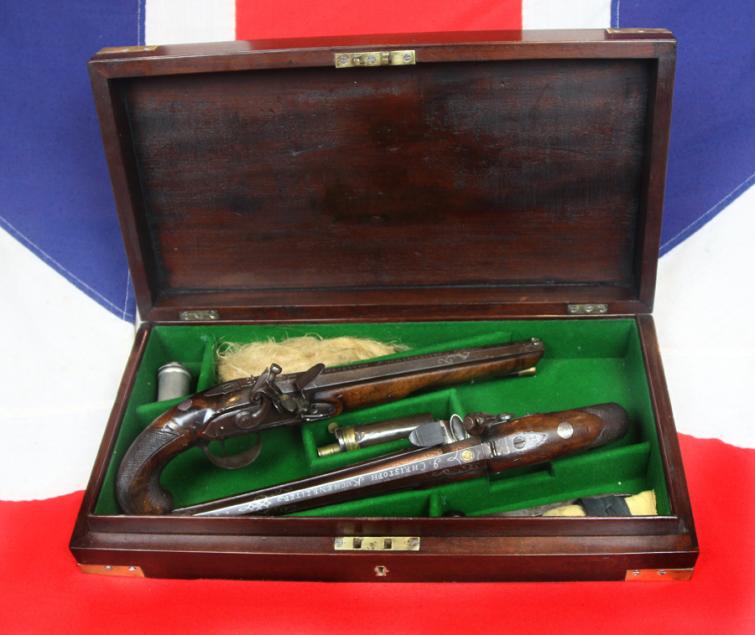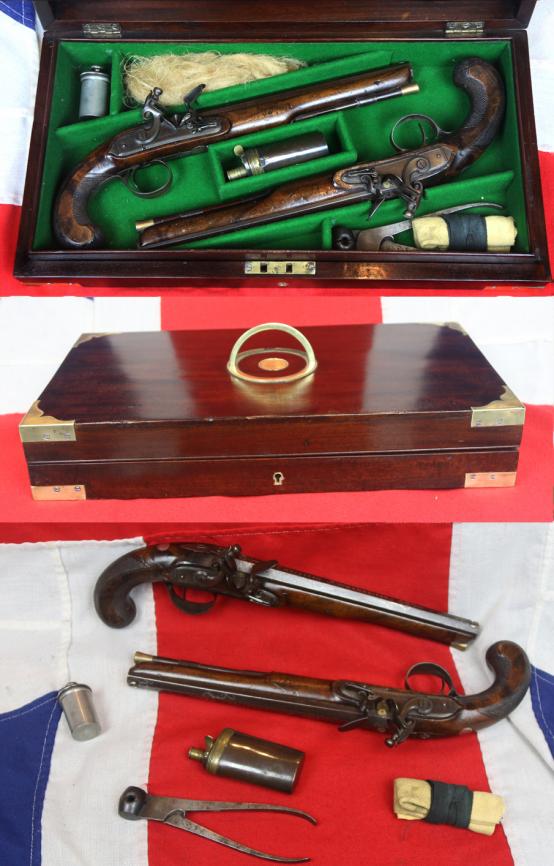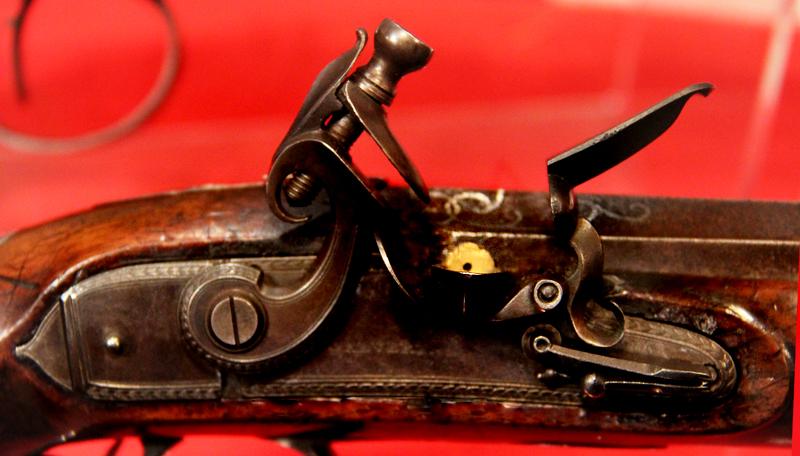A Very Fine Pair of Cased 1800's English, Historical, Rifled Duelling Pistols, of Capt Robert Lloyd RN, Outstanding Hero of the War of 1812, Capturing 25 American Vessels, With Finest Silver Inlaid Barrels by Johann Christoph Kuchenreiter.
King George IIIrd, Napoleonic Wars and War of 1812 period. An absolutely stunning pair of original and finest, English cased duelling pistols, made for the British naval hero, Capt. {later admiral} Robert Lloyd, famed for his dozens of successful and incredible naval engagements achieved during the Anglo-American War of 1812 alone. Each pistol bears his engraved, personal monogram on their trigger guards, and his family crest engraved within the pistols silver escutcheons.
His heroic service in His Majesty’s Royal Navy included the Quiberon Expedition, the invasion of France in 1795, aka the Battle of Quiberon which was a major landing on the Quiberon peninsula by émigré, counter-revolutionary troops and the royal navy, in support of the Chouannerie and Vendée Revolt, beginning on 23 June and finally definitively repulsed on 21 July.
He was most famed as a hero of the Anglo-US War of 1812, capturing an incredible 25 US naval vessels and their crews in just 4 months up to December 1813. He was also the one of the first naval captains to be attacked by a torpedo, under the new US Torpedo act. ‘Fulton’s torpedo’ was designed to sink Capt Lloyds ship HMS Plantagenet in the Chesapeake under the personal instruction of the US Secretary of the Navy William Jones. Fortunately it exploded too soon without harming Lloyds ship.
During his war service in the Royal Navy, Captain Lloyd captured many warships, and well deserved his reputation as a British naval hero and a captain of immense success in combat against the enemies of King George.
We are proud to offer and present Captain R Lloyd's {later Admiral of the White}, cased set of finest, bespoke, English duelling pistols, fitted with a pair of fabulous, unique, silver inlaid rifled barrels, made by one of Europe's finest and revered barrel makers, the great J. Christoph Kuchenreiter of Bavaria, bearing his gold, stamped poincons at the top of the breech.
The duelling pistols are set in it's stunning, baize lined mahogany case, complete with a two way powder flask, a ball mould, coconut wadding, chamois polishing cloth and an oil bottle. It was often the case that an officer and a gentleman, when commissioning a pair of finest pistols, would specify, if they had considerable means, the fitting of a pair of finest imported barrels. German rifled barrel maker's were, with good reason, considered to be some of the finest rifled barrel makers in the world.
The stocks are finest Juglans Regia walnut, and the steel mounts and lock bear some of the very best craftsmanship England’s gunsmiths had to offer. After very considerable, and diligent family research the intriguing potential history of these finest duelling pistols is detailed herein. Apparently, research shows, they were originally from the estate, over some 150 years past, of the late Admiral Robert Lloyd RN 'Admiral of the White'. Originally, and most likely, they were either commissioned by him direct, or, presented to him during his most distinguished career. They are simply a pair of the some of the most beautiful duelling pistols we have had the privilege to offer during the past 50 years.
He was a Royal naval flag rank officer of distinction who served at the Glorious Ist of June, in the Anglo French War, the Quiberon Invasion, the Napoleonic Wars against Napoleon, and, later, in the middle of the Napoleonic Wars, he served in the War of 1812 in America.
During the War of 1812 the US government approved the innovative and experimental use of a torpedo in order to sink his ship, HMS Plantagenet, and thus sabotage its blockade of New London.
The pistols bear his personal engraved monogram upon the trigger guard, and his Lloyd's family silver crest, of a lion argent, engraved within two silver cartouches at the pistols wrists. It would intriguing and reasonable to assume these fabulous cased pistols accompanied Captain Lloyd aboard his vessels during some of his incredible and eventful times during his heroic career. They were made by the Calvert brothers, who were fine English gunsmith's who worked from premises together at 73 Briggate, Yorkshire, between 1804-1822. The barrels are by one of the greatest Bavarian rifled barrel makers in Europe, Johann Christoph Kuchenreiter, and are thus inlaid with his name in gold. These are simply outstanding examples of the highest-grade flintlock pistol barrels, produced by the world renowned and famous Bavarian gunsmith Johann Christoph Kuchenreiter. Kuchenreiter was part of a dynasty of Bavarian gunsmiths that produced highest quality arms for many of the royal houses of the various Germanic states and Austria. His pistols and barrels are in the British Royal Collection, and examples of his work are in all of the finest museum arms collections in the world. If the barrels alone could be replicated today, inch by inch, which would be extremely unlikely, by such as the finest bespoke gun makers in the world has to offer, such as Purdey of London, they would likely cost £150,000 or more. The duelling pistols bespoke, finest English case, showed considerable and unattractive salt water staining upon its surface, which is why it deservedly required its recent expert conservation and restoration, in order to return it to how it would have originally looked, some 220 odd years ago. However, the pistols themselves have been completely untouched, as their condition remained so good, so they retain all their original natural age and use patina as they have acquired over the past 220 years.
Their beauty and quality, combined with the unique history of their original most distinguished owner, makes them an historical pair of finest English duellers beyond compare. One can venture to say these are an example of a pair of the finest English duellers still in existence today.
Robert H Lloyd. Vice-Admiral of the White, was born 24 March, 1765, and died 17 Jan. 1846, at his family seat, at Tregayan, county Anglesey.
Young master Lloyd entered the Navy, on the 31 March, 1779, as a Captain's Servant, on board the HMS Valiant a 74 gunner, then as a Midshipman berth in HMS Fairy under Capts. Berkeley, Keppel, and Brown, he was wounded in a sharp action which preceded the capture of that sloop by the French frigate Madame. After a captivity of some time in France, he was prisoner-exchanged around March, 1781, and on his return to England was received on board the Medway a 74 gunner, under Capts. Harwood and Edgar. He next, between May, 1782, and July, 1787, served on the Channel station in HMS Hebe a frigate, under Capts. Keppel and Edw. Thornbrough, and on 22 Nov. 1790, he was promoted to the rank of Lieutenant. Obtaining an appointment, in Dec. 1792, to the Latona 38, Capts. Thornbrough and Hon. Arthur Kaye Legge, Mr. Lloyd fought under the former of those officers in the action of 1 June, 1794; and on rejoining him as Senior Lieutenant in HMS Robust, he served in Lord Bridport's action, and was severely wounded in the expedition to Quiberon. On 6 Dec. 1796 he was promoted to the command of HMS Racoon in the North Sea; where, after a short running fight, in which the Racoon had 1 person, the Master, killed, and 4 wounded, he succeeded in taking, on 11 Jan. 1798, Le Policrate a French privateer, of 16 guns and 72 men;and, on 22 of the same month, La Pensee, of 2 guns, 9 swivels, and 32 men. Capt. Lloyd, who had previously captured Les Amis, of 2 guns, 6 swivels, and 31 men, made further prize, 20 Oct. following, at the end of a running action of two hours, of La Vigilante, of 14 guns and 50 men. Prior to his attainment of Post-rank 6 Dec. 1799, he had the increased good fortune to sink a French lugger, and to eifect the capture of the privateers Le Vrai Decide, of 14 guns, 4 swivels, and 41 men, and L'Intrepide, of 16 guns and 60 men, 13 of whom were killed and wounded. On the latter occasion he unfortunately received a wound in the head from a half-Pike. His last appointments were ? 12 Jan. 1801, to the Mars 74, bearing the flag of Rear-Admiral Thornbrough in the Channel, where he remained until April, 1802 to 25 March, 1807, to the Hussar 38, in which ship, after assisting at the reduction of Copenhagen, he visited North America and the West Indies 31 May, 1809, and 25 Sept. 1810, to the Guerriere 40, and Swiftsure 74, flagship of Sir John Borlase Warren, both on the North American station and, 11 Feb. 1812 (after ten months of half-pay), to the Plantagenet 74. Continuing in the latter vessel until paid off in April, 1815, Capt. Lloyd was at first employed in the Baltic, and afterwards again in North America, where he captured a large number of coasters, and accompanied the expeditions against Washington and New Orleans. He commanded HMS Plantagenet in the Chesapeake campaigns 1813-15 in the War of 1812. In Spring 1813, the US Congress passed the Torpedo Act, offering rewards to any private citizen who succeeded in blowing up a British vessel. During the British blockade of New London, Connecticut, on June 25, 1813, a schooner loaded with explosives blew up next to the 74-gun ship of the line HMS Ramillies killing one British naval officer and ten Royal Navy seamen. While not exactly a torpedo attack, the incident sent a clear message that open warfare was declared on enemy war vessels while in United States waters. Adm. Sir John Borlase Warren, chief of the North American naval station blustered, "the Enemy are disposed to make use of every unfair and Cowardly mode of warfare." Another British naval officer labelled the use of torpedoes "a most dastardly method of carrying on the war."
On the 26th of September, 1814, the General Armstrong was lying at anchor in the road of Fayal. Her master was Samuel Chester Reid, and she had a crew of ninety men on board. A British squadron, composed of HMS Plantagenet, 74 gunner Captain Robert Lloyd, HMS Rota, 38, Captain Philip Somerville; HMS Carnation, 18, Commander George Bentham, hove in sight towards sundown. Experience had wisely taught the Americans not to trust to the neutrality of a weak Power for protection; and Reid warped his brig near shore, and made ready to repel any attempt to cut her out. Soon after dark Captain Lloyd sent in four boats. He asserted that they were only sent to find out what the strange brig was; but of course no such excuse was tenable. Four boats, filled with armed men, would not approach a strange vessel after nightfall merely to reconnoitre her. At any rate, after repeatedly warning them off, Reid fired into them, and they withdrew. He then anchored, with springs on his cables, nearer shore, and made every preparation for the desperate struggle which he knew awaited him. Lloyd did not keep him long in suspense. Angered at the check he had received, he ordered seven boats of the squadron, manned by about a hundred and eighty picked men, to attack the privateer. He intended the Carnation to accompany them, to take part in the attack; but the winds proved too light and baffling, and the boats made the attempt alone. Under the command of Lieutenant William Matterface, first officer of HMS Rota, they pulled in under cover of a small reef of rocks, .where they lay for some time; and, at about midnight, they advanced to the attack.
The Americans were on the alert, and, as soon as they saw the boats rowing in through the night, they opened with the pivot-gun, and immediately afterwards with their long 9 pounders. The British replied with their boat carronades, and, pulling spiritedly on amidst a terrific fire of musketry from both sides, laid the schooner aboard on her bow and starboard quarter. A murderous struggle followed. The men-of-wars' men slashed at the nettings and tried to clamber up on the decks, while the privateersmen shot down the assailants, hacked at them with cutlass and tomahawk, and thrust them through with their long pikes. The boats on the quarter were driven off; but on the forecastle the British cut away the nettings, and gained the deck. All three of the American mates were killed or disabled, and their men were beaten back; but Reid went forward on the run, with the men of the after division, and tumbled the boarders back into their boats. This put an end to the assault. Two boats were sunk, most of the wounded being saved as the shore was so near; two others were captured; and the others, crippled from their losses, and loaded with dead and disabled men, crawled back towards the squadron. The loss of the Americans was slight. Two were killed and seven wounded. The fearful slaughter in the British boats proved that they had done all that the most determined courage could do. Two-thirds of the assailants were killed or wounded. The number killed was 34, including Lieutenants William Matterface and Charles E. Norman. The number wounded was 86, including Lieutenant Richard Rawle, Lieutenant Thomas Park, R.M., Purser William Benge Basden, and two Midshipmen.
The brig's long 24 pounder had been knocked off its carriage by a carronade shot, but it was replaced and the deck again cleared for action. Next day HMS Carnation came in to destroy the privateer, but was driven off by the judicious use of the long-gun. However, as soon as the wind became favourable, the Carnation again advanced. Further resistance being hopeless, the General Armstrong was scuttled and burned, and the Americans retreated to the land.
There is no doubt the Master of the General Armstrong was extremely skilled, capable and worthy of the best that the Royal offered against him. A most admirable adversary, who should have received all due praise at the time, whether it was even offered is another matter entirely.
Use of Fulton's torpedo in the Chesapeake Bay was sanctioned by Secretary of the Navy William Jones who told Capt. Charles Gordon of the Baltimore U.S. Navy station to give every aid to a Mr. Elijah Mix. In a secret memo of May 7, Jones instructed Gordon to furnish Mix with 500 lbs of powder, a Boat, or Boats, and Six men. Mix made several attempts to blow up the ship of the line HMS Plantagenet on blockade duty off the Virginia capes. On July 24, Mix almost succeeded in his plans but the torpedo exploded prematurely, deluging the decks of the British vessel with seawater. It appears from Elijah Mix's April 27, 1815 letter to Secretary of the Navy Benjamin Crowninshield requesting his furlough from the Navy that Mix had been kicking his heels waiting for new employment after his efforts to sink Plantagenet, because Crowninshield's predecessor, Secretary William Jones, suspended the torpedo program:
"Permit me. . . To remark that I have awaited orders at this port New York City since October 1814 when I was released from the torpedo service from the compliment that I had the Honor to receive from the President, after my expedition against the Plantagenet, I had no doubt but I should resume my Command again, in the Chesapeake; but unfortunate for me and my country Mr. Jones was Opposed to torpedoes. I have spent independent of my pay upwards of two thousand Dollars and one years hard service to acquire a perfect knowledge of the use and certainty using those formidable Engines with Effect, but to my mortification all aid has been withdrawn. . . ."
While it possible that Secretary of the Navy Jones caved into British pressure against the use of such a dastardly method of warfare, Hamlin mentions a letter from Jones in which the Secretary gave Elijah Mix a sharp reprimand for not continuing with his efforts to sink the Plantagenet. Thus, the suspension of the program may have had more to do with Jones?s distrust of Elijah Mix's diligence than any submission to British pressure. On the 29th December 1813, HMS Plantagenet was off Bermuda and her commander, Captain Robert Lloyd wrote to his Admiral with a list of his successes against America so far. It was very long:
Sloop Jolly Robin of 4 men and 50 tons, from Boston bound to Charleston, captured September 8 1813.
Schooner Torpedo of 40 tons from New York bound to New Orleans, captured September 11 1813.
Sloop Olive Branch of 50 tons captured same date.
Schooner Delight of 50 tons captured September 15 1813.
Schooner name unknown captured same date.
Schooner Jacks Delight of one gun from New Orleans bound to New York captured October 12 1813.
Schooner Sparrow of 1 gun and 100 tons from New Orleans bound to New York captured November 3 1813.
Sloop Elizabeth of 30 tons captured November 5 1813.
Sloop James Madison of 1 man and 25 tons from New Orleans bound to New York captured November 7 1813.
Sloop Active of 5 men and 57 tons from New York bound to Savannah captured November 12 1813
Sloop Lady Washington of 15 men and 70 tons from Savannah bound to New York captured November 15 1813.
Schooner Betsy of 5 men and 60 tons from Savannah bound to New York, captured November 21 1813.
Schooner Margaret and Mary of 5 men and 37 tons from Philadelphia boudn to New York captured November 27 1813.
Sloop Anna Maria of 7 men and 60 tons from Philadelphia bound to New York captured same date.
Schooner John and Mary of 60 tons from New Orleans bound to New York captured November 29 1813.
Sloop Five Sisters of 5 men and 60 tons from New York bound to Philadelphia captured December 2 1813.
Sloop New Jersey of 42 tons from Barnygatebound to New York captured same date.
Sloop Two Peters of 3 men and 38 tons from Little Egg bound to New York captured same date.
Schooner Batsch of 3 men and 61 tons from New York bound to Little Eggcaptured December 4 1813.
Schooner Unicorn of 6 men and 30 tons from Savannah bound to New York captured December 5 1813.
Schooner Margaret of 2 men and 36 tons from New York bound to Barnygate captured December 8 1813
Sloop Victory of 60 tons from Savannah bound to New York captured December 10 1813.
Schooner Little Mary of 3 men and 26 tons from New York bound to Charleston captured December 12 1813.
Schooner Rapid of 21 men, 1 gun and 115 tons from Havannah bound to New York captured December 16 1813.
Schooner Mary of 4 men and 34 tons from Philadelphia bound to Salem captured December 17 1813.
All of the above American vessels and crews were captured by his exemplary bravery, talent, skill and superior mastery of command.
These magnificent duelling pistols have sighted octagonal polygroove rifled barrels fitted with rear leaf sights, they are inlaid in silver with scrolls, and the makers name, I Christoph Kuchenreiter, the breeches are set with the maker's pure gold tablet embossed with tha horse and rider and the initials of J Christoph Kuchenreiter, I C K. In the Georgian and earlier periods, the name initial J was often represented by the capital letter I when used in block text. With border engraved stepped locks, signed by the English maker, incorporating an automatic safety on half cock, French style cocks, rainproof pans, roller frizzens, full stocked with steel mounts, the trigger guards are engraved with the owner's initials of Capt. Robert Lloyd, later Admiral and with pineapple finials, and circular silver escutcheons engraved with the owner's family crest of a demi-lion. They have slab-sided butts, chequered to the fore and rear, and brass capped wooden ramrods. Small stock field repair at the lock area during its working life.
The case has in the recent past been superbly repolished and restored throughout. It is lacking its lock key to the case’s lock.
Code: 23938
28950.00 GBP



